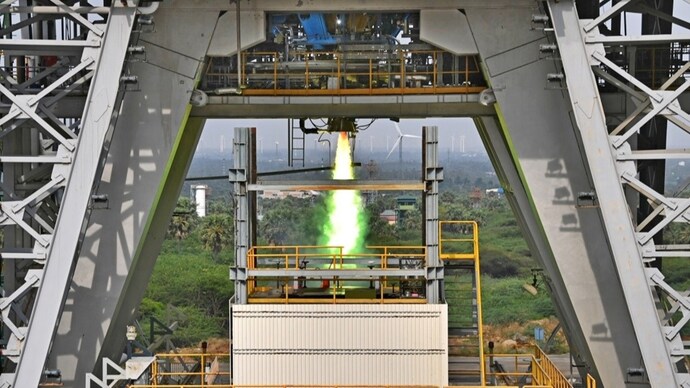Isro conducts successful ignition test for boosting LVM3's capacity
The successful pre-burner ignition test paves the way for the next phase of development, which includes testing the engine powerhead and the fully integrated engine.

In Short
- The semi-cryogenic engine is being developed by ISRO's Liquid Propulsion Systems Centre
- It uses a propellant combination of liquid oxygen (LOX) and refined kerosene (ISROSENE)
- This engine is designed to provide heavy-lift capability to ISRO's upcoming launch vehicles
The Indian Space Research Organisation (Isro) has successfully conducted the first ignition trial of a semi-cryogenic pre-burner at its Isro Propulsion Complex (IPRC) in Mahendragiri, Tamil Nadu.
This achievement marks a crucial step in the development of a 2,000 kN thrust semi-cryogenic engine, which is set to enhance the payload capability of Isro's Geosynchronous Satellite Launch Vehicle Mk III (LVM3) and power future launch vehicles.
The semi-cryogenic engine, being developed by Isro's Liquid Propulsion Systems Centre (LPSC), utilizes a propellant combination of liquid oxygen (LOX) and refined kerosene (IsroSENE). This engine is designed to provide heavy-lift capability to Isro's upcoming launch vehicles, including the Next Generation Launch Vehicle (NGLV).
The successful ignition test, conducted on May 2, 2024, at the newly dedicated Semi-Cryogenic Integrated Engine and Stage Test (SIET) facility, demonstrated the smooth and sustained ignition of the pre-burner, a critical component for the starting of the semi-cryogenic engine.
"The ignition process is one of the most critical parts in the development of liquid rocket engine systems," Isro said in a statement. "With the successful ignition of the semi-cryo pre-burner, a major milestone in the semi-cryo engine development has been achieved."
The ignition was achieved using a start fuel ampule, which combines Triethyle Alumnide and Triethyle Boron, a novel ignition system developed by Isro's Vikram Sarabhai Space Centre (VSSC). This is the first time this technology has been employed in Isro's semi-cryogenic engine development.
The successful pre-burner ignition test paves the way for the next phase of development, which includes testing the engine powerhead and the fully integrated engine.
Additionally, the development of a semi-cryogenic stage with a propellant loading of 120 tons is also underway.
"The development of a semi-cryo stage with 120 tons of propellant loading is also under progress," the Isro added.
The semi-cryogenic engine is a crucial component in Isro's efforts to enhance the payload capacity of its launch vehicles, particularly the LVM3, which is currently powered by the Vikas engine.
The successful ignition test marks a significant milestone in Isro's journey towards achieving self-reliance in the development of advanced propulsion systems for its space program.